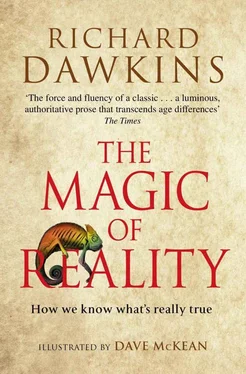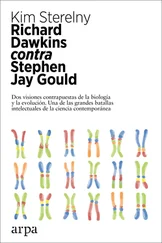How we detect these movements is interesting in its own right. Any star is too far away for us to be able to see it actually moving, even with a powerful telescope. But, strangely, although we can’t see a star move, we can measure the speed with which it does so. That sounds odd, but this is where the spectroscope comes in. Remember the Doppler shift from Chapter 8? When the star’s movement happens to be away from us, the light from it will be red-shifted. When the star’s movement is towards us its light will be blue-shifted. So, if a star has an orbiting planet, the spectroscope will show us a rhythmically pulsating red-blue-red-blue shift pattern, and the timing of these regular shifts will tell us the length of the planet’s year. Of course it’s complicated when there’s more than one planet. But astronomers are good at mathematics and they can cope with that complication. At the time of writing (May 2012) 701 planets have been detected by this means, orbiting 559 stars. There will surely be more by the time you read this.
There are other methods of detecting planets. For example, when a planet passes across the face of its star, a small portion of the face of the star is obscured or eclipsed – like when we see the moon eclipsing the sun, except that the moon looks much bigger because it is so much closer.
When a planet comes between us and its star, the star becomes very very slightly dimmer, and sometimes our instruments are sensitive enough to detect this dimming. So far, 230 planets have been discovered in this way. And there are a few other methods, too, which have detected another 62 planets. Some planets have been detected by more than one of these techniques, and the present grand total is 763 planets orbiting stars in our galaxy other than the sun.
In our galaxy, the great majority of stars where we have looked for planets have turned out to possess them. So, assuming our galaxy is typical, we can probably conclude that most of the stars in the universe have planets in orbit around them. The number of stars in our galaxy is about 100 billion, and the number of galaxies in the universe is about the same again. That means something like 10,000 billion billion stars in total. About 10 per cent of known stars are described by astronomers as ‘sun-like’. Stars that are very different from the sun, even if they have planets, are unlikely to support life on those planets for various reasons: for example, stars that are much bigger than the sun tend not to last long enough before exploding. But even if we confine ourselves to the planets orbiting sun-like stars we are likely to be dealing in billions of billions – and that would probably still be an underestimate.
All right, but how many of those planets orbiting the ‘right kind of star’ are likely to be suitable for supporting life? The majority of extra-solar planets discovered so far are ‘Jupiters’. That means they are ‘gas giants’, mostly made of gas at high pressure. This is not surprising, as our methods of detecting planets are usually not sensitive enough to notice anything smaller than Jupiters. And Jupiters – gas giants – are not suitable for life as we know it. Of course, that doesn’t mean that life as we know it is the only possible kind of life. There might even be life on Jupiter itself, although I doubt it. We don’t know what proportion of those billions of billions of planets are Earth-like rocky planets, as opposed to Jupiter-like gas giants. But even if the proportion is quite low, the absolute number will still be high because the total is so huge.
Life as we know it depends on water. Once again, we should beware of fixing our attention on life as we know it, but for the moment exobiologists (scientists searching for extraterrestrial life) regard water as essential – so much so that a good part of their effort is given over to searching the heavens for signs of it. Water is a lot easier to detect than life itself. If we find water it certainly doesn’t mean there has to be life, but it is a step in the right direction.
For life as we know it to exist, at least some of the water has to be in liquid form. Ice won’t do, nor will steam. Close inspection of Mars shows evidence of liquid water, in the past if not today. And several other planets have at least some water, even if it is not in liquid form. Europa, one of the moons of Jupiter, is covered with ice, and it has been plausibly suggested that under the ice is a sea of liquid water. People once thought Mars was the best candidate for extraterrestrial life within the solar system, and a famous astronomer called Percival Lowell even drew what he claimed were canals criss-crossing its surface. Spacecraft have now taken detailed photographs of Mars, and have even landed on its surface, and the canals have turned out to be figments of Lowell’s imagination. Nowadays Europa has taken the place of Mars as the prime site of speculation about extraterrestrial life in our own solar system, but most scientists think we have to look further afield. Evidence suggests that water is not particularly rare on extra-solar planets.
What about temperature? How finely tuned does the temperature of a planet have to be, if it is to support life? Scientists talk of a so-called ‘Goldilocks Zone’: ‘just right’ (like baby bear’s porridge) between two wrong extremes of too hot (like father bear’s porridge) and too cold (like mother bear’s porridge). The orbit of Earth is ‘just right’ for life: not too close to the sun, where water would boil, and not too far from the sun, where all the water would freeze solid and there wouldn’t be enough sunlight to feed the plants. Although there are billions and billions of planets out there, we cannot expect more than a minority of them to be just right, where temperature and distance from their star are concerned.
Recently (May 2011) a ‘Goldilocks planet’ was discovered orbiting a star called Gliese 581, which is about 20 light years away from us (not very far as stars go, but still a vast distance by human standards). The star is a ‘red dwarf’, much smaller than the sun, and its Goldilocks zone is correspondingly closer in. It has (at least) six planets, named Gliese 581e, b, c, g, d and f. Several of them are small, rocky planets like Earth, and one of them, Gliese 581d, is thought to be in the Goldilocks zone for liquid water. It is not known whether Gliese 581d actually has water, but if so it is likely to be liquid rather than ice or vapour. Nobody is suggesting that Gliese 581d actually does have life, but the fact that it has been discovered so soon after we started looking makes one think there are probably lots of Goldilocks planets out there.
What about the size of a planet? Is there a Goldilocks size – not too big and not too small, but just right? The size of a planet – more strictly its mass – has a big impact upon life because of gravity. A planet with the same diameter as Earth, but mostly made of solid gold, would have a mass more than three times as great. The gravitational pull of the planet would be over three times as strong as we are used to on Earth. Everything would weigh more than three times as much, and that includes any living bodies on the planet. Putting one foot in front of the other would be a great labour. An animal the size of a mouse would need to have thick bones to support its body, and it would lumber about like a miniature rhinoceros, while an animal the size of a rhinoceros might suffocate under its own weight.
Just as gold is heavier than the iron, nickel and other things that Earth is mostly made of, coal is much lighter. A planet the size of Earth but mostly made of coal would have a gravitational pull only about a fifth as strong as we are used to. An animal the size of a rhinoceros could skitter about on thin, spindly legs like a spider. And animals far bigger than the largest dinosaurs could happily evolve, if the other conditions on the planet were right. The moon’s gravity is about one-sixth that of Earth. That is why astronauts on the moon moved with a curious bounding gait, which looked quite comical because of their large bulk in their space suits. An animal that actually evolved on a planet with such weak gravity would be built very differently – natural selection would see to that.
Читать дальше











